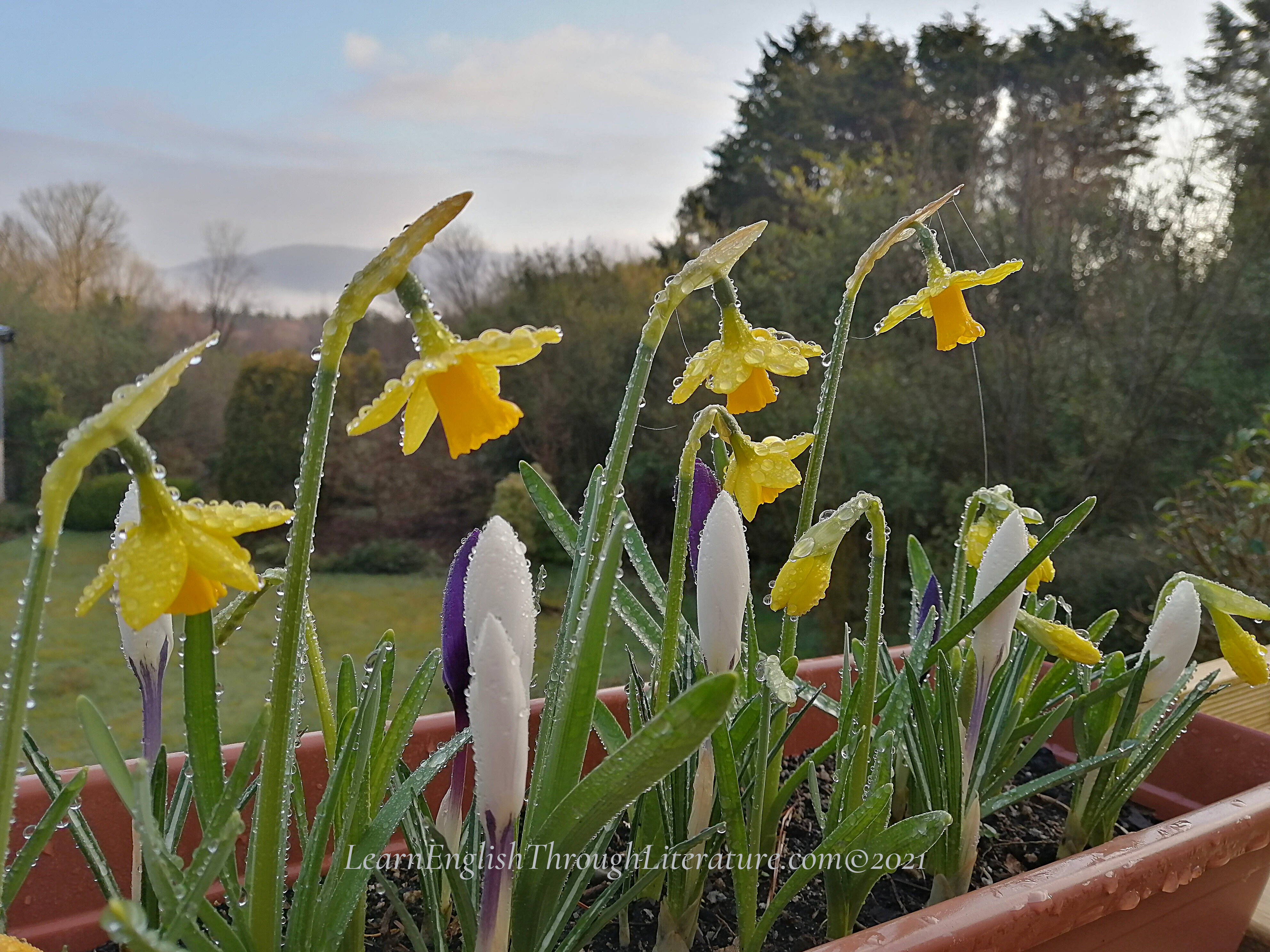🏵️ The first of March – also known as ‘St David’s Day’, Wales’ national day, when the Welsh like to wear small daffodils (or leeks) as a national symbol.
That, together with our own daffodils, crocuses, and snowdrops has brought to mind one of the most famous poems in the English language, William Wordsworth’s ‘The Daffodils’ (1807). It is a ‘must-read’ poem that all English language learners should read at some point. 🌼
✍️ In our Lesson today in two parts, we will first read the whole poem, with the some vocabulary lists and general observations to help us fully understand everything; then in part 2 of this Lesson (next post), we will cover the differences between verbs of seeing – ‘watch’, ‘look’, ‘see’, ‘gaze’, ‘glance’, ‘eye’ – with a few examples of how to use them in a sentence.
If you would like to read ‘The Daffodils’ as a whole, you can find it on the Poetry Foundation website here. And here is another little video on how Wordsworth was inspired to write the poem, filmed on the location (the Lake District) where he would have seen the daffodils and written these famous lines.
…
‘The Daffodils’ (written in 1804, published in 1807)
📜 STANZA 1
I wandered lonely as a cloud
That floats on high o’er vales and hills,
When all at once I saw a crowd,
A host, of golden daffodils;
Beside the lake, beneath the trees,
Fluttering and dancing in the breeze.
✏️ KEY VOCABULARY
Wandered < wander: to walk about without any particular aim, as if lost or else exploring a new place.
On high: above, high up
O’er < over
Vales: valleys (poetic word)
Host: a crowd, especially a majestic or impressive one
Daffodils: Flowers that have six petals, often of a pale yellow or white colour, and a bell-shaped centre in a darker orange or yellow. They also have long greyish-green stalks and leaves, and bloom every spring. In some places, their appearance is seen as the first sign of spring.
Fluttering < flutter: fly or move about unsteadly, quickly, and lightly
Breeze: a light wind blowing in a particular direction
💡 KEY OBSERVATIONS
‘I wandered lonely as a cloud’: Normally, we would phrase this as ‘I wandered as lonely as a cloud’, since ‘lonely is an adjective not an adverb. However, language rules are sometimes adjusted in poetry to match a poem’s rhyme and meter, as here.
..
📜 STANZA 2
Continuous as the stars that shine
And twinkle on the milky way,
They stretched in never-ending line
Along the margin of a bay:
Ten thousand saw I at a glance,
Tossing their heads in sprightly dance.
✏️ KEY VOCABULARY
Continuous: stretching or continuing (in a long line)
Twinkle: (describing the movement of a star or small light) shining in a shaky way that moves from bright to faint light to bright again
the milky way: a bright group of stars (a constellation, galaxy) in the sky
margin: the (narrow) area between two limits: here, the beach or shoreline between the lake and the land.
At a glance: in one quick view
Tossing < toss: throw something (usually one’s hair, or a ball) up in a playful, careless way
Sprightly: fun and lively
💡 KEY OBSERVATIONS
This stanza begins with an adjective, which is a bit unusual: ‘Continuous …’ In other words, the daffodils stretched as continously as the stars that shine and twinkle on the milky way … Notice however that Wordsworth’s choice of words here reflects the right amount of syllables for this line of the poem.
‘They stretched in never-ending line …’ Again, Wordsworth has cut out the article ‘a’ here for the sake of preserving the right number of syllables. We would probably describe his line as ‘they stretched in a never-ending line …’
‘… saw I …’ This is the opposite word order of ‘I saw’ which we found in Stanza 1 and use in day-to-day English. This changed word order of subject and verb form is permissible in English with certain verbs only, verbs such as ‘said’, ‘saw’, etc.
..
📜 STANZA 3
The waves beside them danced; but they
Out-did the sparkling waves in glee:
A poet could not but be gay,
In such a jocund company:
I gazed—and gazed—but little thought
What wealth the show to me had brought:
✏️ KEY VOCABULARY
Out-did: out-performed, did more than (the waves)
Glee: great delight and playful happiness
A poet could not but be gay: a poet could only be gay
Gay: happy, cheerful
Jocund: joyful
But little thought: but I little thought; but I hardly thought
💡 KEY OBSERVATIONS
‘but they / out-did the sparkling waves in glee’: While the waves beside the daffodils seemed to dance, the daffodils did even more dancing (with glee) than the waves were able to do.
‘but be gay’: ‘But’ is often used by native English speakers in this kind of sentence, to stress that something alone is ‘only’ something else. Notice how it is placed between ‘not’ and ‘be’.
..
📜 STANZA 4
For oft, when on my couch I lie
In vacant or in pensive mood,
They flash upon that inward eye
Which is the bliss of solitude;
And then my heart with pleasure fills,
And dances with the daffodils.
✏️ KEY VOCABULARY
Oft: often
Couch: sofa, even sometimes a kind of simple bed
Vacant: empty
Pensive: thoughtful
Flash: appear suddenly with a bright ‘splash’ of light
Inward eye: the mind’s eye, the imagination
Bliss: real, deep happiness
Soliude: the fact or state of being alone
💡 KEY OBSERVATIONS
In poetic language, Wordsworth is describing his imagination as ‘the internal eye’. He says that when he is not thinking about anything in particular, he has vivid memories of the daffodils flash upon him, as if to remind him of these dafodils.
…
👉 Join me in part 2 of this Lesson where we will consider 6 verbs that can be used to describe different ways of seeing.




